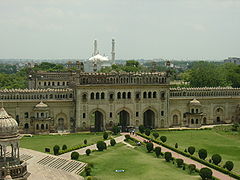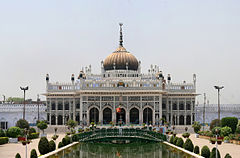
Awadh, known in British historical texts as Avadh or Oudh, is a historical region in northern India, now constituting the northeastern portion of Uttar Pradesh. It is roughly synonymous with the ancient Kosala region of Hindu, Buddhist, and Jain scriptures.

Lucknow is the capital and the largest city of the Indian state of Uttar Pradesh and it is the administrative headquarters of the eponymous district and division. Having a population of 2.8 million as per 2011 census, it is the eleventh most populous city and the twelfth-most populous urban agglomeration of India. Lucknow has always been a multicultural city that flourished as a North Indian cultural and artistic hub, and the seat of power of Nawabs in the 18th and 19th centuries. It continues to be an important centre of governance, administration, education, commerce, aerospace, finance, pharmaceuticals, information technology, design, culture, tourism, music, and poetry.
Bara Imambara, also known as Asafi Imambara, is an imambara complex in Lucknow, India, built by Asaf-ud-Daula, Nawab of Awadh, in 1784. Bara means big. An Imambara is a shrine built by Shia Muslims for the purpose of Azadari. This imambara is the second largest after the Nizamat Imambara.

Mirza Asaf-ud-Daula was the Nawab wazir of Oudh ratified by Shah Alam II, from 26 January 1775 to 21 September 1797, and the son of Shuja-ud-Dowlah. His mother and grandmother were the Begums of Oudh.

Chota Imambara, also known as Imambara Hussainabad Mubarak is an imposing monument located in the city of Lucknow, Uttar Pradesh, India. It took 54 years to finalize it. Built as an imambara or a congregation hall for Shia Muslims, by Muhammad Ali Shah, the Nawab of Awadh in 1838, it was to serve as a mausoleum for himself and his mother, who is buried beside him.

Gomti Nagar is an area in the Indian city of Lucknow consisting of both residential and business settlements. It is one of the largest and fastest-growing areas of Lucknow. It is also considered Asia's largest colony. It is home to high-end residential projects, malls, commercial property, plots, business centers, multiplexes, cafés, hotels, hospitals, clubs, banks, food courts and entertainment centers. The colonies in Gomti Nagar are based on a 'maximum open space' concept hence most of the plots/houses and apartments are park-facing.
Cis-Gomti area is a sub-city in the Lucknow metropolitan area, in the state of Uttar Pradesh, India. The residential settlements in the Cis-Gomti area are: Hazratganj, Aminaabad, Husainganj, Lal Bagh, Golabganj, Wazirganj, Rajendra Nagar, Malviya Nagar, Sarojini Nagar, Aishbagh, Rajajipuram, Chowk, and Saadatganj, Buddheswar
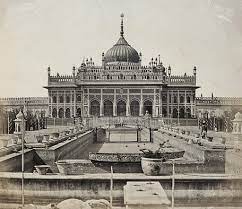
The Lucknow School of Architecture was an experiment by the resurgent Nawabs of Awadh. It was an attempt to preserve the Mughal school of architecture by experimenting with different materials and innovating new concepts.

The Rumi Darwaza, in Lucknow, Uttar Pradesh, India, is a gateway which was built by Nawab Asaf-Ud-Daula in 1784. It is an example of Awadhi architecture. The Rumi Darwaza stands sixty feet tall and was modeled after the Sublime Porte (Bab-iHümayun) in Istanbul.

The Culture of Uttar Pradesh is an Indian culture which has its roots in Hindi, Bhojpuri and Urdu literature, music, fine arts, drama and cinema. Lucknow, the capital of Uttar Pradesh, has historical monuments including Bara Imambara and Chhota Imambara, and has preserved the damaged complex of the Oudh-period British Resident's quarters, which are being restored.

Amjad Ali Shah was the fourth King of Oudh from 7 May 1842 to 13 February 1847.
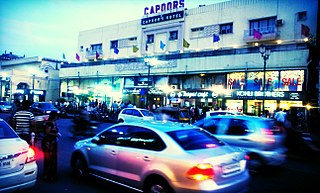
Hazratganj, is the downtown and main shopping hub of Lucknow, the capital and largest city of the Indian state of Uttar Pradesh. In addition to bazaars, it also contains shopping complexes, restaurants, hotels, theatres, cafés and many offices.

Situated in the northern part of India, bordering with the capital of India New Delhi, Uttar Pradesh is one of the most popular and an established tourist destination for both Indians and non-Indians alike in India. The most populous state of India, Uttar Pradesh contains many historical monuments and places of religious significance. Geographically, Uttar Pradesh is very diverse, with Himalayan foothills in the extreme north and the Gangetic Plain in the centre. It is also home of India's most visited sites, Hinduism's holiest city, Varanasi. Kumbh city, Prayagraj. Kathak, one of the eight forms of Indian classical dances, originated from Uttar Pradesh. Uttar Pradesh is at the heart of India, hence it is also known as The Heartland of India. Cuisine of Uttar Pradesh like Awadhi cuisine, Mughlai cuisine and Bhojpuri cuisine are very famous not only in India but also many places abroad.

Ambedkar Memorial Park, formally known as Dr. Bhimrao Ambedkar Samajik Parivartan Prateek Sthal, is a public park and memorial in Gomti Nagar, Lucknow, Uttar Pradesh, India. The memorial is dedicated to B. R. Ambedkar, the 20th century Indian polymath and the first law minister of India.
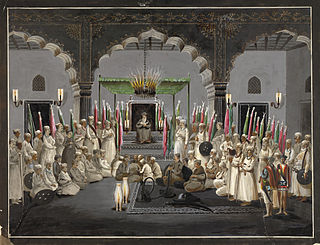
Azadari in Lucknow or Mourning in Lucknow, is name of the practices related to mourning and commemoration of the anniversary of the death of Imam Husayn ibn Ali at the Battle of Karbala in 680, particularly in period of Muharram and in general round the year.
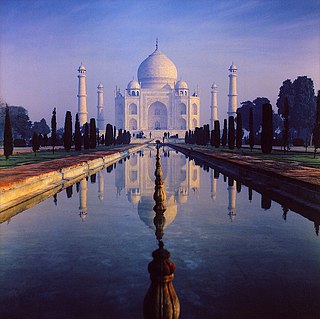
The architecture of Uttar Pradesh demonstrates a diverse and eclectic combination of Buddhist, Hindu, Indo-Islamic, and Indo-European architectural styles. Three of its architectural monuments—the Taj Mahal, the Agra Fort, as well as the township of Fatehpur Sikri founded by the Mughal emperor Akbar—are designated UNESCO World Heritage Sites. The architectural structures in Uttar Pradesh include ancient Buddhist stūpas and vihāras, ancient Buddhist and Hindu monasteries, townships, forts, palaces, temples, mosques, mausoleums, memorials, and other community structures. Uttar Pradesh's architectural structures also include various Hindu temples, Ghats, etc. largely found in ancient cities like Benares (Varanasi), Brindaban (Vrindavan), Mathura, and Prayagraj (Allahabad).
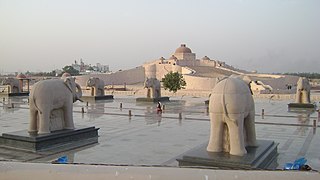
Lohia path is an 8–12 lane road in Lucknow, in the Indian state of Uttar Pradesh, connecting the Hazratganj shopping district with Government Polytechnic, the Gomti Nagar neighborhood and ending at Kalidas Marg, the residence of Uttar Pradesh's chief minister. It displays beautiful railings and lamp posts on both sides. In addition to vehicular lanes, it includes a bicycle track and footpath. It was built under the government of Mulayam Singh Yadav in 2005 and was inaugurated in 2007.
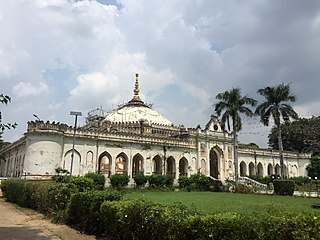
Shah Najaf Imambara is one of the several imambaras in Lucknow.

Husainabad Clock Tower is a clock tower located in the Lucknow city of India. It was constructed by Nawab Nasiruddiin Haider (1827-37) to mark the arrival of Sir George Couper, the lieutenant governor of North -West Province. It was built at a cost 1.75 Lakhs Rs.
Lucknow is known as a city of imambaras as it contains a large number of them, among which, some are very well known.






